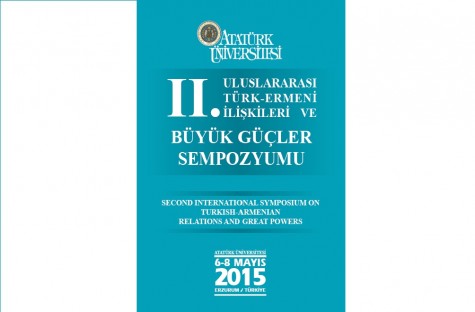
Ömer Engin LÜTEM
25 June 2014
A grand conference was convened in Versailles, France right after the First World War for the preparation of the peace treaties. Representatives of peoples who intended to win their independence attended the conference and made speeches to raise their demands. Boghos Nubar Pasha of Egypt, who represented Ottoman Armenians, demanded around half of present-day Turkey, but these big lands were not given to the Armenians because the southern part was specifically demanded by France as well. Many years later, the then Prime Minister of England, Lloyd George, described these demands as “fairytales of Boghos” in his memoirs. [i]
As the conference faced difficulties in determining the lands to be given to the Armenians, it referred the issue to American President Wilson through an article added in the Treaty of Sèvres. The lands that President Wilson foresaw to be given to Armenia were one third of the lands demanded by Boghos Nubar. Still, these territories constituted a very big land as it included the lands remaining within a circle starting from the west of Trabzon, including Van in the south, reaching the borders of present-day Iran and rounding out at Batum’s west. This land determined by Wilson is four times bigger than present-day Armenia. In the end, let alone seizing this territory, Armenia would be defeated by Turkish forces, would lose its independency in about 40 days after Wilson’s decisionand join the Soviet Union. To briefly sum it up, the borders drawn by Wilson have the characteristics of a “fairytale” as well.
As the conference faced difficulties in determining the lands to be given to the Armenians, it referred the issue to American President Wilson through an article added in the Treaty of Sèvres. The lands that President Wilson foresaw to be given to Armenia were one third of the lands demanded by Boghos Nubar. Still, these territories constituted a very big land as it included the lands remaining within a circle starting from the west of Trabzon, including Van in the south, reaching the borders of present-day Iran and rounding out at Batum’s west. This land determined by Wilson is four times bigger than present-day Armenia. In the end, let alone seizing this territory, Armenia would be defeated by Turkish forces, would lose its independency in about 40 days after Wilson’s decision and join the Soviet Union. To briefly sum it up, the borders drawn by Wilson have the characteristics of a “fairytale” as well.
For the centennial of 1915, the Armenians and the Armenian Diaspora are in preparations for the genocide allegations to be recognized in the widest arena and for various demands from Turkey to be put forward. In this regard, it can be observed that the borders drawn by Wilson are being brought to the agenda again.
Tomorrow, we will touch on another fairytale, demands by the Dashnak Party.
[i] David Lloyd George, The Truth About the Peace Treaties, London, 1938. p.1316
© 2009-2025 Center for Eurasian Studies (AVİM) All Rights Reserved
No comments yet.
-
FRANCE’S NEW PRESIDENT AND THE ARMENIANS
Ömer Engin LÜTEM 07.05.2012 -
ARMENIA 2013 (2)
Ömer Engin LÜTEM 07.01.2012 -
AUSTRIA AND LUXEMBURG: EFFORTS TO REPAIR RELATIONS
Ömer Engin LÜTEM 04.10.2015 -
THE ARMENIAN QUESTION AFTER THE HOLIDAYS II
Ömer Engin LÜTEM 05.09.2011 -
ARMENIA 2013 (1)
Ömer Engin LÜTEM 06.01.2013
-
 DISMISSED FORMER FRONTEX CHIEF FINDS HIMSELF A NEW POSITION
DISMISSED FORMER FRONTEX CHIEF FINDS HIMSELF A NEW POSITION
Hazel ÇAĞAN ELBİR 04.03.2024 -
 THE SECOND DAY OF THE SECOND INTERNATIONAL SYMPOSIUM ON TURKISH-ARMENIAN RELATIONS AND GREAT POWERS ORGANIZED BY ATATÜRK UNIVERSITY IN ERZURUM
THE SECOND DAY OF THE SECOND INTERNATIONAL SYMPOSIUM ON TURKISH-ARMENIAN RELATIONS AND GREAT POWERS ORGANIZED BY ATATÜRK UNIVERSITY IN ERZURUM
AVİM 06.05.2015 -
 ARMENIA COUNTRY GENDER ASSESSMENT REPORT
ARMENIA COUNTRY GENDER ASSESSMENT REPORT
Şakire (FURTUN) TAHNAL 26.08.2015 -
AUSTRIA AND LUXEMBURG: EFFORTS TO REPAIR RELATIONS
Ömer Engin LÜTEM 04.10.2015 -
 NEWLY APPOINTED SECRETARY GENERAL OF THE COLLECTIVE SECURITY TREATY ORGANIZATION AND RUSSIAN DOMINANCE OVER ARMENIA
NEWLY APPOINTED SECRETARY GENERAL OF THE COLLECTIVE SECURITY TREATY ORGANIZATION AND RUSSIAN DOMINANCE OVER ARMENIA
Hazel ÇAĞAN ELBİR 03.05.2017
-
25.01.2016
THE ARMENIAN QUESTION - BASIC KNOWLEDGE AND DOCUMENTATION -
12.06.2024
THE TRUTH WILL OUT -
27.03.2023
RADİKAL ERMENİ UNSURLARCA GERÇEKLEŞTİRİLEN MEZALİMLER VE VANDALİZM -
17.03.2023
PATRIOTISM PERVERTED -
23.02.2023
MEN ARE LIKE THAT -
03.02.2023
BAKÜ-TİFLİS-CEYHAN BORU HATTININ YAŞANAN TARİHİ -
16.12.2022
INTERNATIONAL SCHOLARS ON THE EVENTS OF 1915 -
07.12.2022
FAKE PHOTOS AND THE ARMENIAN PROPAGANDA -
07.12.2022
ERMENİ PROPAGANDASI VE SAHTE RESİMLER -
01.01.2022
A Letter From Japan - Strategically Mum: The Silence of the Armenians -
01.01.2022
Japonya'dan Bir Mektup - Stratejik Suskunluk: Ermenilerin Sessizliği -
03.06.2020
Anastas Mikoyan: Confessions of an Armenian Bolshevik -
08.04.2020
Sovyet Sonrası Ukrayna’da Devlet, Toplum ve Siyaset - Değişen Dinamikler, Dönüşen Kimlikler -
12.06.2018
Ermeni Sorunuyla İlgili İngiliz Belgeleri (1912-1923) - British Documents on Armenian Question (1912-1923) -
02.12.2016
Turkish-Russian Academics: A Historical Study on the Caucasus -
01.07.2016
Gürcistan'daki Müslüman Topluluklar: Azınlık Hakları, Kimlik, Siyaset -
10.03.2016
Armenian Diaspora: Diaspora, State and the Imagination of the Republic of Armenia -
24.01.2016
ERMENİ SORUNU - TEMEL BİLGİ VE BELGELER (2. BASKI)
-
AVİM Conference Hall 24.01.2023
CONFERENCE TITLED “HUNGARY’S PERSPECTIVES ON THE TURKIC WORLD"









